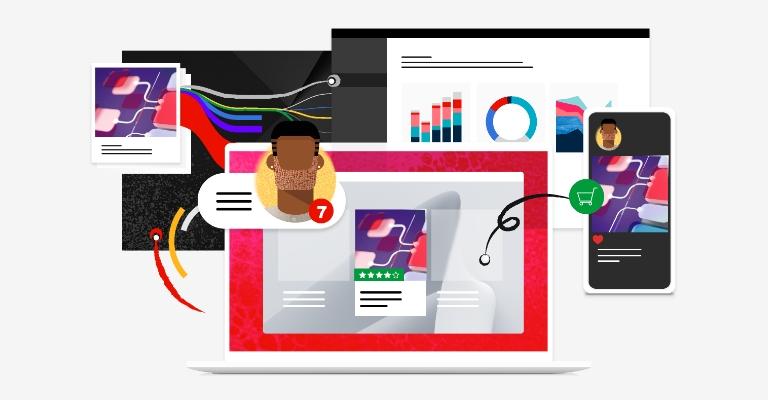Avon’s Gianfranco Cuzziol on how loyalty schemes deliver value and where the metaverse fits in.
Purple Square have been speaking to customer experience leaders from top global brands about Reimagining Customer Experience (CX). In this interview Tim Biddiscombe speaks to Gianfranco Cuzziol, International CRM and Personalisation Lead at Avon.
As with any marketing endeavour, knowing your audience is essential when it comes to building and running an effective loyalty programme. Whether it’s all about collecting points in exchange for products and discounts, or building a more exclusive ‘club’, loyalty schemes are a two-way street between brands and their customers. The trade-off for customers is the knowledge that their data is being collected and (hopefully) being used to offer them something they want, need or even to create a meaningful experience tailored to them.
If brands get it right, their loyalty programme can play a hugely important role in providing a positive customer experience.
Understanding value
The first step to building an effective loyalty programme is for the brands to ask themselves why they have one in the first place. In other words, to clearly identify the scheme’s objectives and ensure they are adding value to the organisation, as well as the customer.
“The term ‘value accelerator’ isn’t widely used to describe loyalty programmes, but I like it,” explained Gianfranco. “Essentially it means that brands should take a holistic view. They should look at all the loyalty schemes they may have in play and evaluate what’s working. If certain schemes aren’t adding or accelerating value for the business or their customers, then it’s either not the right fit, or it’s not necessary.”
“Put simply, unless it’s solving a problem or meeting a desire, personalisation – and by extension, a loyalty scheme – is pointless. If it’s of no value to the customer then it’s of no value.”
Understanding the value – or lack thereof – any given scheme has to the business as a whole all comes back to the objectives of the loyalty programme.
“For some brands a simple, transactional approach to loyalty makes sense,” explained Cuzziol. “The value of My McDonalds Rewards, for example, lies in the fact that it helps get people through the door and buying their food. It is all about driving transactions, rather than enhancing the experience.”
For other more lifestyle-focused brands, the value of loyalty programmes lies in cultivating and personalising customer experiences. While accelerating data capture may be at the root of these programmes, their aim goes beyond a transactional approach. They seek to create emotional connections between customers and the brand, building engagement, creating communities and making customers feel included.
This approach not only helps to reinforce customers decisions to share their name and details with the company they’ve signed up to, but to cultivate an ongoing relationship between the brand and the member.
As with The Body Shop’s ‘Love your Body’ loyalty scheme, these types of programmes may start with initial discounts to incentivise the customer to begin with, before moving to a more exclusive and experience-based approach.
“The Body Shop offers regular discounts and incentives in the first sixty days after a customer signs up to help encourage them to keep their products top of mind – and in their baths, showers and bedrooms,” explained Cuzziol. “From there it quiets down. Customers continue to earn points and rewards they can redeem, but the messaging changes from discounts to experiences and exclusive offers for members.”
In other words, it becomes less about discounts and more about being connected to the brand, about being part of a community. About belonging.
The perfect fit
Defining and understanding the purpose of your loyalty programme not only helps ensure that it is accelerating value for the business, but that it fits with the nature of the brand.
“As an example, Aesop’s vision for loyalty is very different,” said Cuzziol. “As a luxury brand it is less overt than more mainstream lifestyle brands. It is based on recognition, not transactions. They take a more behind the scenes approach to extend the tenure of relationships with customers. Recognising and rewarding their long term-loyalty.”
“Even if a customer’s only purchase is a gift set each year for Christmas, they want to recognise that. They might send the brand book to customers who show loyalty year after year as a thank you for valuing the brand.”
In addition to appreciating customers with thank you gifts, inviting feedback or involvement can be an excellent way for some brands to build communities of loyal customers and to ensure their products are in line with what their customers want.
“If we are reformulating a product, we want our customers who regularly buy it to be part of it,” explained Cuzziol. “We will send them samples and ask for their thoughts, invite them to skincare consultation events to talk about the product, attend the launch and make sure they get access to new products ahead of the general public.”
Data and technology drive and guide loyalty schemes
Whether you’re a luxury brand or day to day service, building connections with customers is a key benefit of an effective loyalty programme – and needs to be done at scale. This is where technology is needed. Looking at CRM and personalisation data can help give context to customer interactions with brands and help marketers to spot trends across groups and products.
“CRM, personalisation, CX and loyalty are all linked, you can’t tear them apart,” explained Cuzziol.
At its most basic, loyalty data contributes to a wider picture of key customers, helping brands to understand what they need to get right and where they can afford to go wrong when it comes to customer experience. “In the grocery sector, for example, you are much more likely to lose a customer if you repeatedly change or cancel their delivery slot than if they receive a cucumber that’s slightly past it’s best,” he continued.
Beyond this, maximising data to personalise communications to loyalty scheme members helps bring their interaction with the brand to life.
When it comes to creating a positive customer experience, a loyalty scheme that is relevant to your customers can make all the difference. Whether the objective is rooted in building connections, sparking emotions or reassuring your most valued customers, a successful loyalty scheme needs to provide them with something they expect, want or need from your brand.
Like what you see?
Subscribe to our newsletter for customer experience thought leadership and marketing tips and tricks.




